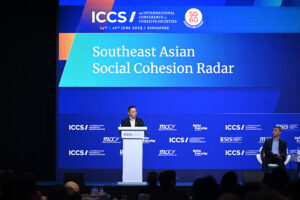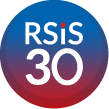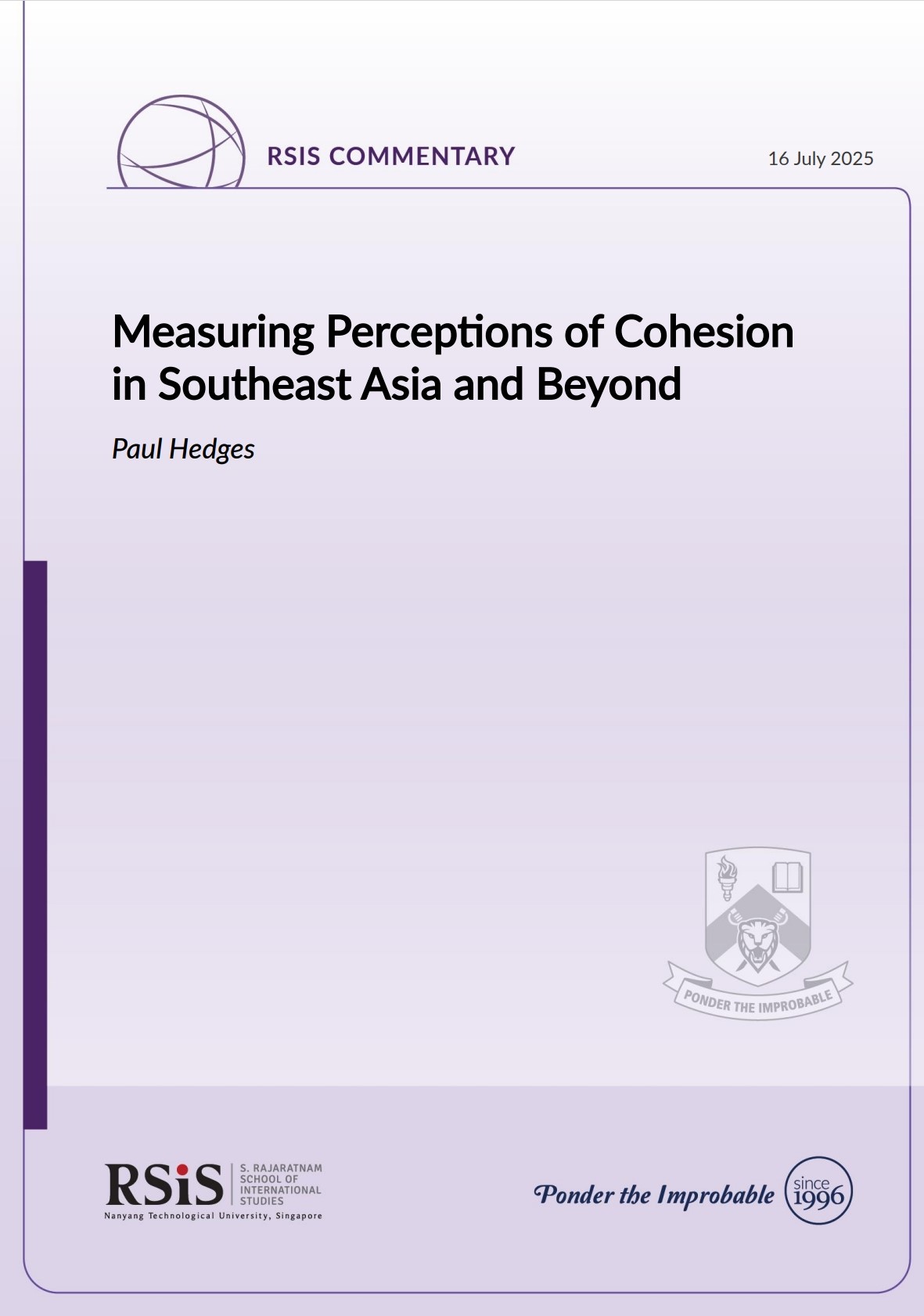16 July 2025
- RSIS
- Publication
- RSIS Publications
- Measuring Perceptions of Cohesion in Southeast Asia and Beyond
SYNOPSIS
The “Southeast Asian Social Cohesion Radar” presented at the International Conference on Cohesive Societies in Singapore provides a snapshot of the challenges encountered in measuring social cohesion and the policy responses needed going forward.

COMMENTARY
The first and second editions of the Southeast Asian Social Cohesion Radar (SEASCR) were launched at the International Conference on Cohesive Societies (ICCS) organised by the S. Rajaratnam School of International Studies (RSIS) in 2022 and 2025, respectively. This is intended as a long-term contribution of ICCS to help give a longitudinal survey of perceptions of social cohesion in the region.
Based on the Bertelsmann Stiftung methodology, but adapted to the local context, there were differences in method and approach between the SEASCR 2022 and SEASCR 2025 editions. One change was a shift from the perspective of “regional thought leaders” in 2022 to a national representative survey in 2025. For 2022, one hundred leading thinkers (policy makers, academics, intellectuals, etc.) from each country were interviewed, while in 2025 a sample of the population (one thousand individuals in each Southeast Asian nation) was polled. Some of the questions in the 2025 survey were fine-tuned to ensure relevance to culture-specific experiences, and a wider and deeper comparative analysis was performed for each country. Both surveyed the same ten ASEAN countries.
What is Social Cohesion?
Before asking about findings or the differences between 2022 and 2025, we should ask what we mean by social cohesion. This is important because we need to know what is being measured. It is also necessary to state something obvious but easily overlooked: We can never measure social cohesion itself; we can only measure perceptions of social cohesion.
There are many definitions of social cohesion. The Bertelsmann metric has three major domains, divided into nine dimensions. The three domains are: People-to-people connections, or the horizontal aspect of cohesion; state-to-people connections, or the vertical aspect of cohesion; and the common good aspect, or people’s willingness to contribute communally.
Another framework developed by the current author suggests three crucial factors for social cohesion: trust and respect, or the day-to-day connections between people; unity in diversity, or the acceptance and embrace of diversity; and resilient identities, solid bonds that may be built by working together and going beyond mere toleration. These concepts can be further expanded upon or other definitions explored.
Can We Quantify Cohesion?
Social cohesion is somewhat nebulous and hard to define, as seen by the varying definitions. Perhaps it is about “hearts and minds” and so inexpressible? Notwithstanding this limitation, since many policymakers and academics want to quantify it numerically, we should note some caveats.
First, any measure of cohesion is a snapshot in time, made in a particular location. SEASCR 2022 took place just after the COVID-19 pandemic and was a unique picture. In 2025, there are various geopolitical issues which may be causing tensions in society. Moreover, societies change. When the Bertelsmann Stiftung team first measured cohesion in Asia, they found Hong Kong to be the most cohesive society, but in the following months, its social fabric ruptured as mass anti-government protests took place.
Second, quantitative measures of social cohesion may track majoritarian in-group sentiment and fail to capture the dissatisfaction, even deep resentment, arising from the oppression of small social minorities. Both the 2022 and 2025 editions of the SEASCR include some qualitative measures, but the overall metrics may still be misleading.
Suffice it to say, looking at metrics alone can be problematic.
Who is the Most Cohesive?
Neither edition of SEASCR is intended as a scorecard or a ranking exercise. But many readers would be interested in how the countries ranked, whether highest or lowest. In 2022 and 2025, the high and low ends were both different.
In 2022, Singapore was perceived as the most socially cohesive; notably, this was an aggregate score from all ten states surveyed. In 2025, it was the sample of the population of Vietnam polled that ranked that country as highest. Conversely, in 2025 Singapore came sixth, and in 2022 Vietnam had come fifth. The data does not, however, allow us to claim that either is the most cohesive society, or that there had been a jump between them during these years.
We only have, it must be remembered, perceptions and snapshots in time. Moreover, the data is different: In 2022, it was based on thought leaders’ perspectives, in 2025, national representative samples; and the questions were not entirely identical. Further analysis suggests why each may be perceived differently.
Vietnam is a Communist country, and like many such states, there is a strong central narrative of unity. This may make the population feel strongly united, although it is often assumed – and various surveys in the Western context show this – that authoritarian states tend to have lower social cohesion. The context of the country is also important. For Vietnam, the robust economic growth in recent years has fostered a strong sense of triumph, especially having overcome hardship and becoming united after a devastating civil war.
Singapore, with the highest Gross Domestic Product per capita in Southeast Asia (no. 4 globally), following typical Western metrics where cohesion and wealth often correlate, may be assumed to be the most cohesive regionally. However, the 2025 SEASCRs showed that GDP did not always correlate with social cohesion scores. Singapore also has a strong government narrative on unity, but Singaporeans have greater access to social media and diverse opinions. The government also has a discourse of “precarious toleration”, warning that cohesion is easily broken.
The above is not a definitive answer on the variations, but a reflection on the context. The scores may not be inaccurate, but data and metrics are never the whole picture.
Cohesion Forward
Singapore should not despair if perceived as the sixth most cohesive society in ASEAN. As noted, SEASCR is not a scorecard. Moreover, the government is investing a lot of time, resources, and energy in building cohesion and developing resilience. The well-worn “Not if, but when” phrase of SGSecure might make Singaporeans aware that cohesion is fragile but also prepares us for readiness when tested. Even if Singapore had topped out in both the 2022 and 2025 surveys, it would be no reason for complacency. We have seen many places where seemingly cohesive societies have fallen apart in short order. Indeed, social cohesion is never built, but only ever a work in progress needing constant effort in a changing world.
Moving beyond comparisons, policymakers and others wanting to learn from the SEASCR may look at these areas: 1) Which aspects of social cohesion seem stronger or weaker in a specific nation; 2) Especially with further editions, what are the long-term trends; 3) Looking at the country specific breakdowns, which groups – whether this is ethnic, linguistic, or gender based – seem most marginalised; and 4) what societal divides exist, i.e., intergenerational, urban-rural, etc.
Furthermore, not just Singapore, but every nation, both in Southeast Asia and beyond, needs to put resources into ongoing efforts to build social cohesion and resilience, train peacebuilders and conflict resolution experts in the good times so they can be deployed when needed, and to put particular investment in youth programmes. Young people are the future in the here and now and are needed – as an ICCS 2025 panel was named – for “cohesion forward”.
About the Author
Dr Paul Hedges is Professor of Interreligious Studies and Associate Dean (Scholarly Ecosystems) based in the Studies in Inter-Religious Relations in Plural Societies (SRP) Programme, S. Rajaratnam School of International Studies (RSIS), Nanyang Technological University (NTU), Singapore, and a Life Member of Clare Hall, University of Cambridge, UK.
SYNOPSIS
The “Southeast Asian Social Cohesion Radar” presented at the International Conference on Cohesive Societies in Singapore provides a snapshot of the challenges encountered in measuring social cohesion and the policy responses needed going forward.

COMMENTARY
The first and second editions of the Southeast Asian Social Cohesion Radar (SEASCR) were launched at the International Conference on Cohesive Societies (ICCS) organised by the S. Rajaratnam School of International Studies (RSIS) in 2022 and 2025, respectively. This is intended as a long-term contribution of ICCS to help give a longitudinal survey of perceptions of social cohesion in the region.
Based on the Bertelsmann Stiftung methodology, but adapted to the local context, there were differences in method and approach between the SEASCR 2022 and SEASCR 2025 editions. One change was a shift from the perspective of “regional thought leaders” in 2022 to a national representative survey in 2025. For 2022, one hundred leading thinkers (policy makers, academics, intellectuals, etc.) from each country were interviewed, while in 2025 a sample of the population (one thousand individuals in each Southeast Asian nation) was polled. Some of the questions in the 2025 survey were fine-tuned to ensure relevance to culture-specific experiences, and a wider and deeper comparative analysis was performed for each country. Both surveyed the same ten ASEAN countries.
What is Social Cohesion?
Before asking about findings or the differences between 2022 and 2025, we should ask what we mean by social cohesion. This is important because we need to know what is being measured. It is also necessary to state something obvious but easily overlooked: We can never measure social cohesion itself; we can only measure perceptions of social cohesion.
There are many definitions of social cohesion. The Bertelsmann metric has three major domains, divided into nine dimensions. The three domains are: People-to-people connections, or the horizontal aspect of cohesion; state-to-people connections, or the vertical aspect of cohesion; and the common good aspect, or people’s willingness to contribute communally.
Another framework developed by the current author suggests three crucial factors for social cohesion: trust and respect, or the day-to-day connections between people; unity in diversity, or the acceptance and embrace of diversity; and resilient identities, solid bonds that may be built by working together and going beyond mere toleration. These concepts can be further expanded upon or other definitions explored.
Can We Quantify Cohesion?
Social cohesion is somewhat nebulous and hard to define, as seen by the varying definitions. Perhaps it is about “hearts and minds” and so inexpressible? Notwithstanding this limitation, since many policymakers and academics want to quantify it numerically, we should note some caveats.
First, any measure of cohesion is a snapshot in time, made in a particular location. SEASCR 2022 took place just after the COVID-19 pandemic and was a unique picture. In 2025, there are various geopolitical issues which may be causing tensions in society. Moreover, societies change. When the Bertelsmann Stiftung team first measured cohesion in Asia, they found Hong Kong to be the most cohesive society, but in the following months, its social fabric ruptured as mass anti-government protests took place.
Second, quantitative measures of social cohesion may track majoritarian in-group sentiment and fail to capture the dissatisfaction, even deep resentment, arising from the oppression of small social minorities. Both the 2022 and 2025 editions of the SEASCR include some qualitative measures, but the overall metrics may still be misleading.
Suffice it to say, looking at metrics alone can be problematic.
Who is the Most Cohesive?
Neither edition of SEASCR is intended as a scorecard or a ranking exercise. But many readers would be interested in how the countries ranked, whether highest or lowest. In 2022 and 2025, the high and low ends were both different.
In 2022, Singapore was perceived as the most socially cohesive; notably, this was an aggregate score from all ten states surveyed. In 2025, it was the sample of the population of Vietnam polled that ranked that country as highest. Conversely, in 2025 Singapore came sixth, and in 2022 Vietnam had come fifth. The data does not, however, allow us to claim that either is the most cohesive society, or that there had been a jump between them during these years.
We only have, it must be remembered, perceptions and snapshots in time. Moreover, the data is different: In 2022, it was based on thought leaders’ perspectives, in 2025, national representative samples; and the questions were not entirely identical. Further analysis suggests why each may be perceived differently.
Vietnam is a Communist country, and like many such states, there is a strong central narrative of unity. This may make the population feel strongly united, although it is often assumed – and various surveys in the Western context show this – that authoritarian states tend to have lower social cohesion. The context of the country is also important. For Vietnam, the robust economic growth in recent years has fostered a strong sense of triumph, especially having overcome hardship and becoming united after a devastating civil war.
Singapore, with the highest Gross Domestic Product per capita in Southeast Asia (no. 4 globally), following typical Western metrics where cohesion and wealth often correlate, may be assumed to be the most cohesive regionally. However, the 2025 SEASCRs showed that GDP did not always correlate with social cohesion scores. Singapore also has a strong government narrative on unity, but Singaporeans have greater access to social media and diverse opinions. The government also has a discourse of “precarious toleration”, warning that cohesion is easily broken.
The above is not a definitive answer on the variations, but a reflection on the context. The scores may not be inaccurate, but data and metrics are never the whole picture.
Cohesion Forward
Singapore should not despair if perceived as the sixth most cohesive society in ASEAN. As noted, SEASCR is not a scorecard. Moreover, the government is investing a lot of time, resources, and energy in building cohesion and developing resilience. The well-worn “Not if, but when” phrase of SGSecure might make Singaporeans aware that cohesion is fragile but also prepares us for readiness when tested. Even if Singapore had topped out in both the 2022 and 2025 surveys, it would be no reason for complacency. We have seen many places where seemingly cohesive societies have fallen apart in short order. Indeed, social cohesion is never built, but only ever a work in progress needing constant effort in a changing world.
Moving beyond comparisons, policymakers and others wanting to learn from the SEASCR may look at these areas: 1) Which aspects of social cohesion seem stronger or weaker in a specific nation; 2) Especially with further editions, what are the long-term trends; 3) Looking at the country specific breakdowns, which groups – whether this is ethnic, linguistic, or gender based – seem most marginalised; and 4) what societal divides exist, i.e., intergenerational, urban-rural, etc.
Furthermore, not just Singapore, but every nation, both in Southeast Asia and beyond, needs to put resources into ongoing efforts to build social cohesion and resilience, train peacebuilders and conflict resolution experts in the good times so they can be deployed when needed, and to put particular investment in youth programmes. Young people are the future in the here and now and are needed – as an ICCS 2025 panel was named – for “cohesion forward”.
About the Author
Dr Paul Hedges is Professor of Interreligious Studies and Associate Dean (Scholarly Ecosystems) based in the Studies in Inter-Religious Relations in Plural Societies (SRP) Programme, S. Rajaratnam School of International Studies (RSIS), Nanyang Technological University (NTU), Singapore, and a Life Member of Clare Hall, University of Cambridge, UK.





